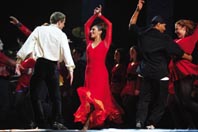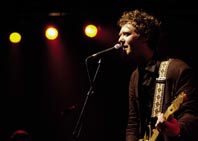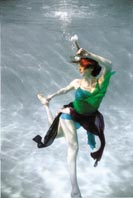Full of blarney and the gift of the gab, the Irish are renowned for their writers as much as for their whiskeys. Thousands of tourists line up every year to kiss a limestone rock in a castle in Ireland's Cork county. The kisser, goes the legend, will be imparted with the gift of persuasive eloquence (Blarney).
Chinese tourists can kiss the Blarney stone now too, Ireland having signed a tourism entry deal with China two months ago. Irish eloquence is trying to seduce the Chinese market on its home ground however, trying to make Ireland and its culture more relevant for in the Middle Kingdom.
The Spirit of China and Ireland Concert at Beijing's National Library Concert Hall in late May was proof of how disparate but potent a combination of the two nations can be. A stage of Chinese and Irish musicians played a specially commissioned new piece of contemporary music from Professor Jia Daqun of the Shanghai Conservatory of Music composed for Irish and Chinese traditional instruments and voices. Jia Daqun, a painter by training and a respected composer of contemporary music, imported the principles of form, line and color from Chinese calligraphy into his musical compositions. And so it sounded. Incredibly ambitious, the piece was stunning in its melding of the picks, flicks and gongs of instruments native to the two countries.
It wasn't the first time the two music canons were mixed. In 1984 Irish traditional super-group The Chieftains became one of the first Western music groups ever to tour China, recording with local musicians and performing a legendary set on the Great Wall. The group, ageing now, couldn't make it back to open the festival on May 9th as planned but the organizers came up with probably the most potent calling card for Ireland among the Chinese: Riverdance.

The Chinese gave a small-scale Riverdance a huge welcome when they opened the festival on May 9th at Beijing's Poly Theater. Good news indeed for a show that is celebrating its tenth year and in danger of flagging. The Irish dance and traditional music show had a very successful run in China last October and, according to a spokesperson, will be coming back this autumn for a longer tour. The show could end up being Ireland's most lucrative export to China.
Later this year Chinese artists and performing troupes will depart for Ireland for the return leg of the Ireland China Cultural Exchange, a massive program of cultural events being staged in the two countries this year. Economics more than culture have so far been linking China and Ireland. Thousands of young Chinese have flocked to Ireland to study English and take a job under an Irish government scheme that allows foreign students to work while studying. "We'd be lost without the Chinese workers," says Harry Mitchell, a taxi driver in Dublin. "We don't have the workers anymore and the Chinese are staffing shops and restaurants. They're great workers, and we're very happy to have them." China and Ireland have surprisingly much in common in their respective paths to economic progress. Just as China initiated its opening up policy in the late 1970s, under the First Program for Economic Expansion (1958-63), economic protection was dismantled in Ireland and foreign investment encouraged. This prosperity brought profound social and cultural changes to what had been one of the least technologically advanced countries in Europe. Ireland joined the European Economic Community (now the EU) in 1973. As in latter-day China, massive social changes followed, climaxing perhaps in the 1990 election of socialist and feminist Mary Robinson as the country's first woman president.
Just as the Chinese imperial dynasties patronized the arts and dictated the development of literature, the ancient Irish elite were educated and fond of the arts. But, unlike Chinese poetry committed to scrolls and stone, their scholarship was entirely oral: educators resented the written word believing it impaired memory and concentration. Ireland was later however the only cultural bright spot in all of Europe. For most of Europe, the period between the sacking of Rome by the Visigoths (410AD) and the crowning of Holy Roman emperor Charlemagne (800AD) was the Dark Ages, a time of war, disease and doom. It was however Ireland's Golden Age. And while imperial China was producing great masterpieces during the 6th and 7th centuries, students from all over Europe flocked to Irish monastery-schools which were then among the most prominent centres of scholarship in the Western world. Irish monasteries also dispatched scholar-missionaries to the rest of Europe.

Religious art, such as the Ardagh Chalice and the Book of Kells flourished alongside pagan artistic achievements such as the Tara Brooch and the great epic tale, the Tain Bo Cuailgne (The Cattle Raid of Cooley). Central to a major exhibition of Irish Art at Beijing's Millennium Monument, Louis le Brocquy's Tain Tapestries are a modern-art reflection on the ancient tale by the man considered by many to be Ireland's greatest living artist. The tapestries grew out of le Brocquy's set of ink illustrations for the translation of the Tain legend by the Irish poet Thomas Kinsella.
The Tain series traveled to China as part of Views from an Island: Irish Contemporary Art from the Collection of the Irish Museum of Modern Art (IMMA), a selection of works from Ireland' s leading gallery for contemporary art. Later in 2004, the IMMA will host a reciprocal exhibition of contemporary art from China jointly curated with the Shanghai Art Museum. The group exhibition in Beijing looked at a cross section of ideas and issues currently bugging Irish artists, illustrated through a variety of media. Many of these issues reflect the major social and economic changes that Ireland has been experiencing in recent years. Chinese art students and artists were assiduously taking notes and photos on the Saturday this writer visited the show, taken perhaps by the variety of creative technique and media employed by the Irish artists whose works were exhibited.
Waiting For Godot, the most famous play by Nobel Prize winner Samuel Beckett, baffled and challenged Chinese audiences. An introductory booklet distributed at the Beijing's Capital Theater described Beckett's pioneering work well: his "...bleak imaginary landscapes examined the incomprehensible reality of humanity through new dramatic and literary forms... Beckett tirelessly explored the human condition in his work..." The seats were mostly filled and the event was well covered by the local media. But the play's preponderance on language, the sparse set and lack of movement were so strange to Chinese, even with helpful subtitling, as to question the choice of play by festival organizers. "I didn't know whether it's supposed to be funny or if you're supposed to be just reverential. I know the play is about waiting for a man to arrive but otherwise I didn't understand the significance of the storyline."
The Yan Club gallery-performance space in Beijing's Dashanzi art district landed one of the biggest gigs of its short existence with acclaimed Irish electronica DJ David Holmes, known for his soundtrack work on films like Ocean's 11 and In the Name of the Father as much as for his remixing work with rock compatriots U2. Holmes played to a late-night audience of Chinese clubbers and expats over-awed to be in the presence of a genuine giant of club music. A week later rock band The Frames flew in from Dublin to play two hours of the folk rock that's made them cult standard bearers in Europe. "We'd love to come back," the band's vocalist Glen Hansard told his audience. Half way through his set the Dubliner invited any Chinese singer in the audience to come onto the stage. He didn't know until afterwards that the slight figure who had climbed onto the stage for one song was Cui Jian, the acknowledged godfather of Chinese rock.
The China Ireland Cultural Exchange also brought together the National Ballet of China and one of Ireland's leading young choreographers, Liz Roche, for a week of classical and contemporary dance. The program featured three dance works including the premiere of a new contemporary dance piece called Catalyst performed by members of the China National Ballet together with Irish dancers with Irish music and lighting talents. More thought-provoking to Chinese modern dance fans, the Coisceim troupe (named after the Irish word for footstep), performed Mermaids, an adaptation of the 19th century Danish storyteller Hans Christian Anderson's work The Little Mermaid.

Mermaids packed the small performance hall at Beijing's Capital Theatre. But perhaps only a tiny percentage of China's population will have sat in the audience of the Irish Cultural Festival events. Most of the Chinese masses were probably unaware that the festival was even running. The two peoples however saw other later in the summer when the two national broadcasters, Radio Telefis Eireann (RTE) and China Central Television (CCTV) screened a selection of each other's programmes. Irish journalists who traveled to China filed dozens of newspaper and television stories that will certainly have encouraged Irish interest and curiosity in China. One of the country's most popular arts broadcasters, John Kelly, produced a whole week of radio shows on Chinese folk and rock music.
Several million euros later, Ireland's arts establishment is calculating the payback of the trip to China. Policymakers at the Department of Foreign Affairs in Dublin has placed a lot of store in the festival's ability to raise Ireland's profile in China while trade boards attempt to harness the goodwill created by the Irish arts establishment. "Cultural festivals are ways in for business," said Gunter Verbruggen, a Frankfurt-based arts journalist who's covered several German cultural festivals in China. "They're token events aimed at the elite of Chinese society and government. It's an offering, not something that sets the whole of Beijing or Shanghai alight. Cultural aficionados and expats get to enjoy great culture and the tickets are usually given away so it can't be a financial success. It's a whole load of money, which may be better spent. Nobody knows exactly how useful these events are but if you can touch influential people you get access. It's unfortunately not about capturing the imagination of a nation."
(China Today September 10, 2004)

